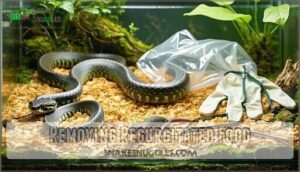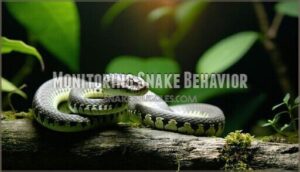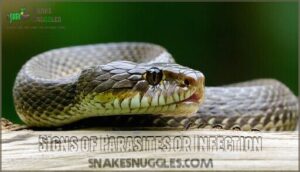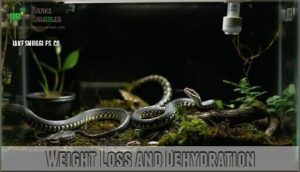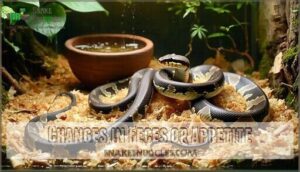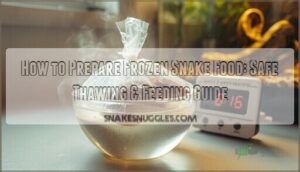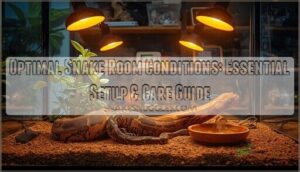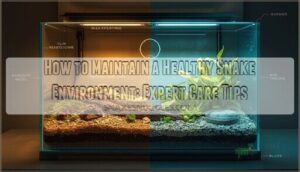This site is supported by our readers. We may earn a commission, at no cost to you, if you purchase through links.

Withhold food for 7-14 days to allow digestive recovery – this isn’t cruel, it’s necessary. Monitor your snake closely for lethargy, respiratory issues, or repeated episodes.
Check your temperature gradients since 87% of regurgitation cases stem from faulty thermostat calibration. Temperature drops disrupt enzyme activity while oversized prey overwhelms their system.
Don’t panic, but don’t ignore it either – regurgitation strips essential nutrients and can lead to dangerous dehydration. The key signs that separate a minor hiccup from a veterinary emergency might surprise you.
Table Of Contents
Key Takeaways
- Act immediately when regurgitation occurs – You’ll need to safely remove the regurgitated meal with gloves and tongs, then completely clean and disinfect the entire enclosure with reptile-safe products.
- Withhold food for 7-14 days to allow digestive recovery – Don’t rush back to feeding as your snake’s system needs time to heal, and this fasting period isn’t cruel but necessary for proper recovery.
- Check your temperature gradients since 87% of cases stem from faulty thermostat calibration – Temperature drops disrupt enzyme activity while oversized prey overwhelms their digestive system.
- Monitor closely for warning signs that require veterinary care – Watch for repeated episodes, lethargy, respiratory issues, or dehydration as these indicate serious health problems beyond simple husbandry mistakes.
Why Did My Snake Regurgitate?
Regurgitation happens when your snake can’t properly digest its meal and brings it back up.
This stressful event occurs due to temperature issues, oversized prey, illness, or environmental changes that disrupt normal digestion, which can be considered a stressful event.
Incorrect Temperature or Humidity
Something’s wrong when your snake’s temperature gradient isn’t right.
Inadequate basking temperatures below 78°F delay digestion, while sudden drops disrupt enzyme activity.
Your thermostat calibration matters—87% of regurgitation incidents link to faulty monitoring equipment.
Species requirements vary, but most need 75-89°F gradients with proper humidity levels between 50-70%.
Environmental temperature correction within 24 hours often resolves issues.
Oversized or Inappropriate Prey
Your snake’s "eyes were bigger than its stomach" if you fed prey larger than 1.5 times your snake’s widest body part.
Oversized prey items overwhelm the digestive system, extending digestion time beyond normal limits.
This mismatch in prey dimensions creates mechanical stress, forcing regurgitation as a protective response.
Overfeeding can also lead to respiratory and digestive issues.
Stick to appropriately-sized prey variety to prevent nutritional deficiencies and maintain proper feeding frequency for ideal snake feeding success.
Illness or Parasitic Infection
Hidden health problems often trigger regurgitation episodes in captive snakes. Parasitic infections, bacterial invasion, and viral diseases disrupt normal digestion, causing your snake to bring up meals unexpectedly.
Silent killers lurk inside your snake—parasites and infections strike without warning, turning healthy digestion into emergency regurgitation
Watch for these warning signs of illness:
- Parasite screening reveals microscopic invaders like Cryptosporidium causing chronic regurgitation
- Bacterial infections create mucoid or bloody diarrhea alongside digestive upset
- Viral infections like Inclusion Body Disease cause repeated vomiting episodes
- Oral infections develop from contaminated prey or poor enclosure sanitation
- Gastric infections inflame stomach lining, preventing proper food breakdown
Internal parasites remain invisible until fecal sample testing reveals their presence. A bacterial infection may follow initial regurgitation if you don’t address underlying causes promptly. Snakes may also develop a dangerous respiratory disease alongside regurgitation.
Environmental Changes
Beyond parasites and illness, your snake’s environment itself can trigger regurgitation.
Moving to a new enclosure, changing substrate type, or adjusting lighting needs creates stress that disrupts digestion. Even minor habitat enrichment additions can overwhelm sensitive snakes.
Sudden fluctuation in environmental temperature or enclosure conditions forces your pet’s system to prioritize survival over food processing.
| Change Type | Common Triggers | Snake Response |
|---|---|---|
| Enclosure Size | Upgrade to larger tank | Temporary feeding refusal |
| Substrate Type | Switch from paper to aspen | Exploration stress behavior |
| Temperature Control | New heating system installed | Digestive slowdown occurs |
| Seasonal Shifts | Winter cooling period | Metabolic rate decreases |
| Snake Enclosure | Complete habitat overhaul | Multi-day adjustment period |
Immediate Steps After Regurgitation
When your snake regurgitates, quick action protects both your pet’s health and prevents bacterial growth in the enclosure.
The next few hours are critical for your snake’s recovery and determining whether this was a one-time event or signals a serious health problem.
Removing Regurgitated Food
Once you’ve determined why regurgitation occurred, your next priority is immediate removal of the regurgitated material. Swift action prevents contamination risks and controls odor that can stress your snake further.
Act quickly to remove regurgitated food using these steps:
- Use disposable gloves and tongs for safe handling of contaminated material
- Place everything in a sealed plastic bag for immediate disposal
- Remove any soiled substrate around the regurgitation site
Quick removal protects your snake’s health and maintains proper snake enclosure hygiene. Don’t let regurgitated food sit—bacteria multiply rapidly in warm, humid environments. Some keepers use F10 disinfectant-soaked paper towels for initial cleanup before full substrate cleaning, which helps prevent contamination risks and controls odor.
Cleaning and Disinfecting The Enclosure
After removing the regurgitated material, you’ll need to thoroughly clean every surface of your snake’s enclosure.
Clean every surface thoroughly—bacteria multiply rapidly in warm, humid snake environments
Safe disinfectants like F10 disinfectant work best for killing harmful bacteria without harming your snake. Consider reptile-safe cleaning supplies for superior hygiene.
Replace all substrate completely – don’t just spot-clean dirty areas. Scrub water bowls, decorations, and glass surfaces to eliminate odors and prevent reinfection.
This thorough cleaning helps establish proper quarantine procedures for recovery.
Withholding Food and Handling
After disinfecting your snake’s enclosure, resist the urge to feed or handle your pet. Your snake needs time for Digestion Recovery after regurgitation. Think of it like nursing a queasy stomach – rushing back to normal routine won’t help.
- Feeding Delay: Wait 7-14 days before offering prey items again
- Minimal Handling: Avoid touching your snake during this Observation Period
- Stress Reduction: Keep the environment quiet and stable
- Monitor closely: Watch for signs of illness without disturbing your pet
Monitoring Snake Behavior
After you’ve handled the regurgitated food and cleaned the enclosure, watch your snake closely for behavioral changes. Normal snakes maintain consistent activity levels and explore their habitat regularly.
Document any deviations from typical patterns, as these signal potential complications. One key element is to maintain proper enclosure temperature to support recovery.
| Normal Behavior | Warning Signs |
|---|---|
| Regular movement patterns | Excessive hiding or lethargy |
| Normal shedding cycles | Irregular shed timing |
| Active enclosure exploration | Avoiding favorite basking spots |
Monitor eating habits, social interaction responses, and overall snake health indicators. Changes in these areas often precede serious complications following regurgitation episodes.
Identifying Underlying Health Problems
After your snake regurgitates, you’ll need to watch for signs that point to deeper health issues rather than simple husbandry mistakes.
While a single regurgitation event often stems from temperature problems or oversized prey, repeated episodes or accompanying symptoms suggest parasites, infections, or other medical conditions that require professional attention.
Signs of Parasites or Infection
After cleaning your snake’s enclosure, watch for infection signs that might explain the regurgitation. Tiny black mites crawling on your snake’s head signal external parasite infections.
Internal parasites cause fecal abnormalities, lethargy signs, and persistent weight loss. Bacterial infections often produce oral infections with mouth discharge, while gastric issues create visible mid-body swelling.
Respiratory distress with wheezing indicates serious health problems requiring immediate veterinary attention. A snake’s smooth, shiny scales indicate good health.
Digestive and Respiratory Issues
Respiratory infections often accompany digestive problems in snakes.
When regurgitation occurs alongside breathing issues, you’re dealing with interconnected health problems that require immediate attention. These conditions can escalate quickly without proper intervention.
Watch for these critical warning signs:
- Aspiration Pneumonia – Regurgitated food enters airways, causing severe respiratory distress and bacterial infection
- Mouth Rot – Bacterial infection spreads from digestive tract to oral cavity, creating visible lesions
- Gut Impaction – Digestive blockages worsen when combined with respiratory infections, preventing normal feeding
- Internal Parasites – Weaken immune system, making snakes vulnerable to secondary bacterial infections
- Organ Damage – Chronic respiratory infection combined with digestive issues can cause permanent internal harm
Weight Loss and Dehydration
After repeated regurgitation episodes, your snake’s body weight can drop by 10% or more, creating dangerous electrolyte imbalance and dehydration.
Chronic regurgitation prevents proper nutrient absorption, leading to appetite loss and potential organ damage.
Monitor your snake’s body condition closely during feeding recovery. If weight loss continues despite offering smaller size prey items, veterinary assessment becomes critical to prevent permanent health complications.
Changes in Feces or Appetite
When your snake’s bathroom habits go sideways, you’ll notice troubling changes that signal deeper health problems.
Feces consistency shifts from normal brown logs to watery, bloody, or mucus-filled messes.
Appetite loss often accompanies digestive issues, with snakes refusing meals entirely, and color changes in waste—from green to black—indicate serious concerns.
Undigested food particles in feces suggest poor digestion, while straining defecation points to blockages or infections requiring immediate veterinary attention.
Preventing Future Regurgitation Events
Once you’ve addressed the immediate regurgitation incident, implementing proper preventive measures becomes your most critical long-term strategy.
The right combination of husbandry adjustments and health monitoring can eliminate most future regurgitation episodes before they occur.
Proper Prey Size and Feeding Schedule
Getting the prey size right makes all the difference in preventing regurgitation episodes.
Your snake’s digestive system works best when you follow specific guidelines for both prey dimensions and timing. Ensuring proper prey selection is key to avoiding health risks.
- Prey Size Guide: Choose prey items no larger than 1.5 times your snake’s widest body part
- Feeding Frequency: Adult snakes typically eat every 10-14 days; juveniles need food every 5-7 days
- Optimal Timing: Feed during peak activity hours when your snake’s digestion rate is highest
Optimizing Temperature and Humidity
Temperature plays a vital role in your snake’s digestion.
Maintain proper heat gradients with accurate thermostats to prevent regurgitation.
Create distinct microclimates within the enclosure, allowing your snake to thermoregulate effectively between hot and cool areas.
| Zone | Temperature Range | Purpose |
|---|---|---|
| Hot Spot | 88-95°F (species dependent) | Primary digestion area |
| Cool Area | 75-80°F | Thermoregulation retreat |
| Ambient | 78-85°F | General enclosure temperature |
| Night Drop | 5-10°F reduction | Natural temperature cycling |
Monitor thermostat accuracy weekly and make seasonal adjustments as needed.
Selecting the right reptile heating supplies is essential for creating a healthy environment.
Proper temperature control guarantees ideal digestion and reduces stress-related regurgitation episodes.
Reducing Stress and Handling
Minimize handling snake within 48 hours of eating to prevent stress-induced regurgitation.
Your snake needs undisturbed digestion time to process meals properly.
Beyond feeding windows, thoughtful handling practices reduce overall anxiety levels that contribute to digestive problems.
Key stress-reduction strategies include:
- Gentle Handling: Support your snake’s body weight completely and move slowly during necessary interactions
- Predictable Routines: Maintain consistent feeding schedules and cleaning times to build security
- Secure Enclosures: Provide adequate hiding spots and minimize vibrations from external disturbances
Let your snake rest in a quiet environment with stable conditions for superior snake care.
Routine Health Checks and Quarantine
Regular veterinary visits and quarantine procedures form your defense against contagious disease.
Schedule routine fecal analysis to catch health problems early—this simple test reveals parasites before they cause regurgitation. You can purchase snake supplies for testing.
Isolation protocols require 30-90 days when introducing new snakes or after illness. Visual inspections during quarantine help monitor recovery.
Preventative treatments based on these checks reduce future complications substantially.
When to Seek Veterinary Care
While a single regurgitation episode isn’t always cause for alarm, certain warning signs require professional intervention.
You’ll need veterinary care if regurgitation happens repeatedly or if your snake shows additional symptoms of illness.
Repeated Regurgitation Episodes
If your snake regurgitates more than once, you’re looking at a red flag that demands veterinary intervention.
Multiple episodes create a dangerous cascade of health problems that can quickly spiral out of control.
Here are four warning signs that repeated regurgitation is becoming serious:
- Electrolyte imbalance – Your snake’s body chemistry becomes dangerously unstable
- Secondary infections – Weakened immunity opens doors to oral and gastric diseases
- Respiratory disease – Stress compromises lung function and breathing patterns
- Organ damage – Persistent digestive issues can permanently harm internal organs
Don’t wait for a third strike. Repeated regurgitation signals underlying health problems that won’t resolve on their own, and each episode makes recovery harder for your snake.
Signs of Serious Illness or Lethargy
Red flags emerge when your snake’s body betrays deeper problems beyond simple regurgitation.
Watch for lethargy signs like reduced movement, loss of appetite lasting beyond normal cycles, and respiratory distress marked by mouth breathing or wheezing sounds.
Abnormal feces, oral infections, and noticeable weight loss signal serious illness requiring immediate veterinary attention, which can be marked by respiratory distress.
Diagnostic Tests and Fecal Exams
Beyond visual symptoms, your reptile veterinarian will conduct specific diagnostic tests to pinpoint regurgitation causes.
Proper sample collection and veterinary analysis guarantee test accuracy for identifying hidden health issues.
Key diagnostic procedures include:
- Fecal exams – Detect internal parasites like nematodes and coccidia affecting digestive health
- Blood work – Reveal systemic bacterial infection or organ dysfunction
- Oral swabs – Identify microbial infections in the mouth and throat
- Imaging studies – Locate blockages or structural abnormalities causing digestive problems
These tests distinguish between fecal parasites, environmental stress, and serious underlying conditions requiring targeted treatment.
Maintaining proper snake hygiene is also vital for prevention.
Finding a Reptile Veterinarian
Once testing confirms regurgitation causes, you’ll need a qualified reptile veterinarian for proper snake health management.
Search local animal hospital websites or reptile veterinarian directories for board-certified specialists. Consider vet qualifications, emergency care availability, and cost considerations before choosing.
Effective vet communication about your snake’s vomiting history guarantees accurate specialist referrals and treatment plans. This step is crucial for the overall health and well-being of your snake, ensuring you receive the best possible care from a qualified reptile veterinarian.
Frequently Asked Questions (FAQs)
How long can snakes survive without eating?
Amazingly, snakes can survive months or even a year without food, depending on their species, size, and stored energy reserves.
Their slow metabolism and cold-blooded nature make them incredibly efficient survivors during food scarcity periods, with their slow metabolism being a key factor.
Can regurgitation damage my snakes digestive system?
Yes, regurgitation can damage your snake’s digestive system. Repeated episodes cause stomach lining irritation, dehydration, electrolyte imbalances, and increase infection risk, potentially leading to permanent organ damage if untreated.
What emergency supplies should I keep available?
Keep digital thermometer, reptile-safe disinfectant, clean substrate, fecal collection containers, and your exotic vet’s emergency contact info readily accessible—you’ll desperately need these lifesaving supplies when regurgitation strikes unexpectedly.
How do I safely transport snake to vet?
Use a secure, well-ventilated carrier with paper towels. Keep it dark and quiet. Maintain appropriate temperature during transport. Don’t handle the snake—just move the container gently to minimize stress.
Will my snake remember traumatic regurgitation experiences?
Snakes don’t form lasting traumatic memories like mammals do. Your snake won’t remember the regurgitation experience or develop feeding anxieties. They’ll return to normal feeding patterns once recovered.
Conclusion
Regurgitation can feel like watching your snake’s entire world collapse, but swift action saves the day.
When you encounter "snake regurgitated food what now" scenarios, remember that proper temperature control and appropriate prey sizing prevent 90% of future incidents.
You’ve learned the critical steps: immediate cleanup, extended fasting periods, and careful monitoring.
Most snakes recover completely with proper care, but don’t hesitate to contact a reptile veterinarian if symptoms persist or worsen.
- https://www.merriam-webster.com/dictionary/visceral
- http://www.youtube.com/c/UltimateExoticsReptiles
- https://teespring.com/stores/ultimate-exotics-reptiles
- https://www.instagram.com/ultimateexoticsreptiles/?hl=en
- https://www.reptifiles.com/corn-snake-care-guide/sick-corn-snake-diseases-health/corn-snake-abrasions/

